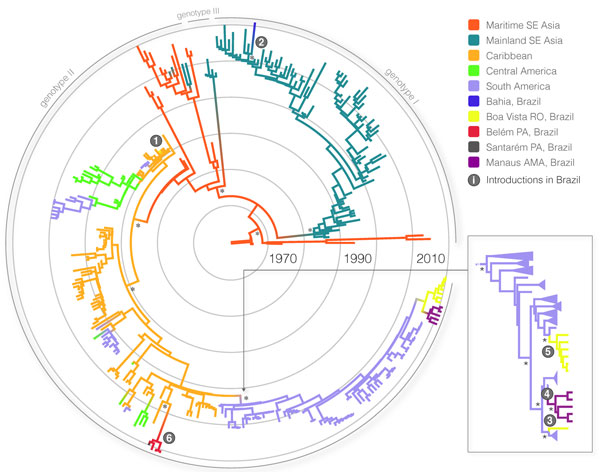Phylogeography of Dengue Virus Serotype 4, Brazil, 2010–2011
Marcio Roberto Teixeira Nunes, Nuno Rodrigues Faria, Helena Baldez Vasconcelos, Daniele Barbosa de Almeida Medeiros, Clayton Pereira Silva de Lima, Valéria Lima Carvalho, Eliana Vieira Pinto da Silva, Jedson Ferreira Cardoso, Edivaldo Costa Sousa, Keley Nascimento Barbosa Nunes, Sueli Guerreiro Rodrigues, Ana Barroso Abecasis, Marc A. Suchard, Philippe Lemey, and Pedro Fernando da Costa Vasconcelos

Author affiliations: Instituto Evandro Chagas, Ananindeua, Brazil (M.R.T. Nunes, H. Baldez Vasconcelos, D. Barbosa de Almeida Medeiros, C. Pereira Silva de Lima, V. Lima Carvalho, E. Vieira Pinto da Silva, J. Ferreira Cardoso, E. Costa Sousa Jr, K.N. Barbosa Nunes, S.G. Rodrigues, P.F. da Costa Vasconcelos); KU Leuven, Leuven, Belgium (N. Rodrigues Faria, P. Lemey); Universidade Nova de Lisboa, Lisbon, Portugal (A. Barroso Abecasis); University of California, Los Angeles, California, USA (M.A. Suchard); and Universidade do Estado do Pará, Belém, Brazil (P.F. da Costa Vasconcelos)
Main Article
Figure 1

Figure 1. . . Maximum clade credibility tree demonstrating the phylogenetic relationships of the 314 dengue virus type 4 (DENV-4) envelope genes (1,485 nt). The major groups (genotypes I–III) are indicated. Branch lengths are scaled in time units; scale bars, representing the chronology of DENV-4 emergence, are color-coded according to the most probable geographic location of the descendent node. Introductions of DENV-4 in Brazil are indicated by numbered circles; numbering follows the temporal order of the mean estimate of divergence time for that particular sequence or clade. In selected nodes, * indicates posterior probability support of 1.00. Panel on right shows a detail of the maximum clade credibility tree (built by using an alignment of 98 DENV-4 full genomes [10,624 nt]) that reveals 3 distinct well-supported introductions of genotype II cluster from neighboring South American countries into Brazil. SE, Southeast; RO, Roraima State; PA, Pará State; AMA, Amazonas State.
Main Article
Page created: October 01, 2012
Page updated: October 01, 2012
Page reviewed: October 01, 2012
The conclusions, findings, and opinions expressed by authors contributing to this journal do not necessarily reflect the official position of the U.S. Department of Health and Human Services, the Public Health Service, the Centers for Disease Control and Prevention, or the authors' affiliated institutions. Use of trade names is for identification only and does not imply endorsement by any of the groups named above.
